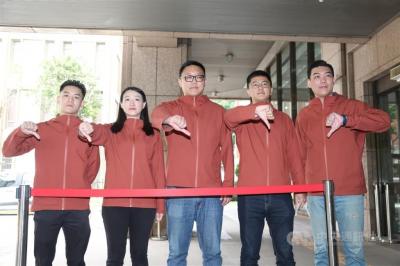The Taipei Zoo celebrated its 99th anniversary yesterday and presented an honorary citizen’s card to the zoo’s star animal — baby panda Yuan Zai (圓仔).
Yuan Zai, the first cub of the giant panda couple Tuan Tuan (團團) and Yuan Yuan (圓圓), is 112 days old and has yet to appear in public.
Taipei Zoo spokesman Chang Chi-hua (張志華) said the zoo will launch a real-time online streaming service by the end of this month for the public to view the cub before her public appearance in January.
The zoo also concluded a naming activity for the baby panda and announced that the nickname given by the zoo, Yuan Zai, would be her official name, as 60 percent of the 75,000 people who voted chose that name.
In presenting the citizen card to a Yuan Zai doll at the celebration ceremony, Taipei Mayor Hau Lung-bin (郝龍斌) said he hoped the popularity of the panda cub would raise public awareness about wildlife preservation.
“Yuan Zai is under great care by zookeepers, and she will meet her fans soon. In the meantime, we hope her popularity will make more people aware about animal protection and preservation,” he said.
Separately, former Chinese Nationalist Party (KMT) chairman Wu Poh-hsiung (吳伯雄) said that the birth of the panda cub in Taipei was an achievement in cross-strait relations.
Wu, who was attending an annual KMT forum with the Chinese Communist Party, invited Association for Relations Across the Taiwan Straits Chairman Chen Deming (陳德銘) to visit Yuan Zai in Taipei.
Tuan Tuan and Yuan Yuan were selected from 23 panda cubs early in 2006 by China as a “gift” to Taiwan following the meeting between former KMT chairman Lien Chan (連戰) and then-Chinese president Hu Jintao (胡錦濤) in 2005. The pair arrived at the Taipei Zoo in 2008.
The zoo will be able to keep Yuan Zai in Taipei because Tuan Tuan and Yuan Yuan were a gift from China.

Taiwan is stepping up plans to create self-sufficient supply chains for combat drones and increase foreign orders from the US to counter China’s numerical superiority, a defense official said on Saturday. Commenting on condition of anonymity, the official said the nation’s armed forces are in agreement with US Admiral Samuel Paparo’s assessment that Taiwan’s military must be prepared to turn the nation’s waters into a “hellscape” for the Chinese People’s Liberation Army (PLA). Paparo, the commander of the US Indo-Pacific Command, reiterated the concept during a Congressional hearing in Washington on Wednesday. He first coined the term in a security conference last

Prosecutors today declined to say who was questioned regarding alleged forgery on petitions to recall Democratic Progressive Party (DPP) legislators, after Chinese-language media earlier reported that members of the Chinese Nationalist Party (KMT) Youth League were brought in for questioning. The Ministry of Justice Investigation Bureau confirmed that two people had been questioned, but did not disclose any further information about the ongoing investigation. KMT Youth League members Lee Hsiao-liang (李孝亮) and Liu Szu-yin (劉思吟) — who are leading the effort to recall DPP caucus chief executive Rosalia Wu (吳思瑤) and Legislator Wu Pei-yi (吳沛憶) — both posted on Facebook saying: “I

Sung Chien-liang (宋建樑), who led efforts to recall Democratic Progressive Party (DPP) Legislator Lee Kun-cheng (李坤城), was released on bail of NT$80,000 today amid outcry over his decision to wear a Nazi armband to questioning the night before. Sung arrived at the New Taipei District Prosecutors’ Office for questioning in a recall petition forgery case last night wearing a red armband bearing a swastika, carrying a copy of Adolf Hitler’s Mein Kampf and giving a Nazi salute. Sung left the building at 1:15am without the armband and covering the book with his coat. Lee said today that this is a serious

A court has approved Kaohsiung prosecutors’ request that two people working for Democratic Progressive Party (DPP) Legislator Lin Dai-hua (林岱樺) be detained, as a probe into two cases allegedly involving her continues. The request was made on Friday, after prosecutors raided Lin’s two offices and the staffers’ residences, and questioned five on suspicion of contravening the Anti-Corruption Act (貪汙治罪條例). The people included the directors of Lin’s Daliao (大寮) and Linyuan (林園) district offices in Kaohsiung, surnamed Chou (周) and Lin (林) respectively, as well as three other staffers. The prosecutors’ move came after they interrogated Lin Dai-hua on Wednesday. She appeared solemn following